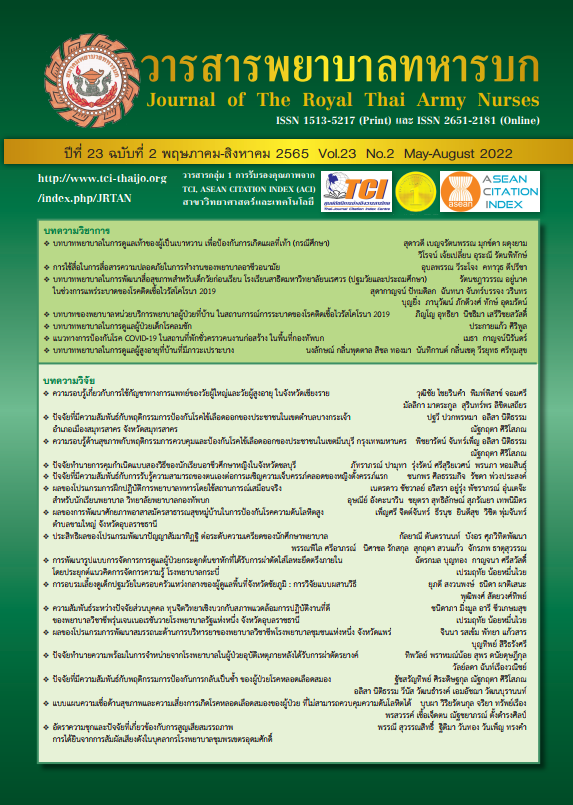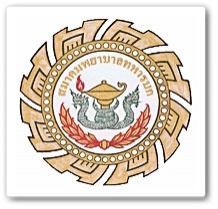Effectiveness of a Nurse-led Educational Program Toward Drowning Prevention Among Preschool Children
Keywords:
Drowning Prevention, Health Beliefs ModelAbstract
The objective of this Quasi-experimental study research was to investigate effectiveness of a nurse-led educational program toward drowning prevention among preschool children by applying the theory of Health Beliefs Model. The sample consisted of 60 preschool children aged 3-5 years and 60 parents in Child Development Centers, Ubon Ratchathani Province. Sample was selected using purposive sampling. The experimental group received a nurse-led educational program toward drowning prevention among preschool children. Children’s activities were to educate and parent’s activities were building perception related to susceptibility, severity, benefits and barriers of drowning among children for parents. The study period was 4 weeks. The data collection tools were the knowledge interviewing for children which reliability (KR-20) was 0.7 and the questionnaire that inquired parents’ perception of susceptibility, severity, benefits, barriers, and behaviors on child drowning prevention with the Cronbach’s alpha reliability coefficient were 0.7, 0.86, 0.86, 0.89 and 0.85, respectively. Data were collected before and after participating in the program. Data were analyzed by descriptive statistics, pair t-test, and independent t-test.
The results of this research indicated that after the experiment, the children in experimental group have higher knowledge score and their parents’ perceived susceptibility, perceived severity, perceived benefits, perceived barriers and parent’s drowning preventive behavior were higher than before and higher than the control group with a statistical significance level (p-value <.05).
Downloads
References
Division of non-communicable diseases, department of disease control. Situation of drowning children in Thailand. Bangkok: Kitjakarnrongpim war veterans’ organization of Thailand office; 2009. (in Thai)
Ministry of public health. Strategy and planning division. Drowning deaths in 2018. Bangkok: Strategy and planning division; 2018. (in Thai)
Ma WJ, Nie SP, Xu HF, Xu YJ, Song XL, Guo QZ, et al. An analysis of risk factors of non-fatal drowning among children in rural areas of Guangdong Province, China: a case-control study. BMC Public Health. 2010; 10(156): 1-8.
Division of injury prevention, Department of disease control. Drowning prevention course for program manager. Nontaburi: Ministry of public health; 2020. (in Thai)
Deepan S, Siriaumpunkul P, Nirattharadorn M. The effects of a program for parents responding to children with difficult temperament on the temperament of preschool children. Journal of The Royal Thai Army Nurses. 2020; 21(3): 131-139. (in Thai)
Office of the education council, Ministry of education. The role of parents, teachers and carers in the upbringing and development of early childhood. Bangkok: Ministry of education; 2011. (in Thai)
Hunnirun P. Documents for teaching subjects SK 531 Behavioral Science in Health Education. Bangkok: Srinakharinwirot University. (in Thai)
Shen J, Pang S, and Schwebel DC. Evaluation of a drowning prevention program based on testimonial videos: A randomized controlled trial. J Pediatr Psychol. 2015; 41(5): 555–65.
Zhu Y, Feng X, Li H, Huang Y, Chen J, and Xu G. A randomized controlled trial to evaluate the impact of a geo-specific poster drowning ‘hotspots’ among children of migrant workers: evidence from Ningbo, China. BMC Public Health. 2017; 17(530): 1-9.
Palittaponkarnpim A. Preventing Injury in early childhood. In: Hunsakunachai T, Rungpriwan R, Sudjaridpong S, Chonchaiya W, editors. Child development and behavior textbook Volume 3. Nontaburi: Beyonenterprise; 2013: 349-55. (in Thai)
Worashotkumjorn J. Promotion of development in children 0-6 years old. In: Watwanichsanong P, Anuntasari W, editors. Pediatrics Volume 1. Bangkok: Sahamit-pattanakarnpim; 2016: 185-89. (in Thai)
Bloom BS. Toxonomy of educational objectives handbook 1: Cognitive. New York: Davidmakay; 1959.
Rogers EM, and Agarwala-Rogers R. Communication in organizations. Journal of Advertising. 1976; 6(2): 49-50.
Janz NK, and Becker MH. The health belief model: a decade later. Health Education Quarterly. 1984; 11(1): 1-47.
Ratchabuntidtayasathan 1999. Knowledge. Bangkok: Nanmeebooks Plublication; 2003: 232. (in Thai)
Kamanee T. 14 teaching methods for professional teachers. 7thed. Bangkok: Tex and Jerinal publishing; 2002: 89. (in Thai)
Kimura A, Keiwkarnka B, and Sillabutra J. Factors related to drowning preventive behavior among caregivers with children aged one to four in rural areas of Thailand. Journal of public health and development. 2013; 11(2): 31-48.
Downloads
Published
How to Cite
Issue
Section
License
Copyright (c) 2022 Journal of The Royal Thai Army Nurses

This work is licensed under a Creative Commons Attribution-NonCommercial-NoDerivatives 4.0 International License.
บทความหรือข้อคิดเห็นใดใดที่ปรากฏในวารสารพยาบาลทหารบกเป็นวรรณกรรมของผู้เขียน ซึ่งบรรณาธิการหรือสมาคมพยาบาลทหารบก ไม่จำเป็นต้องเห็นด้วย
บทความที่ได้รับการตีพิมพ์เป็นลิขสิทธิ์ของวารสารพยาบาลทหารบก
The ideas and opinions expressed in the Journal of The Royal Thai Army Nurses are those of the authors and not necessarily those
of the editor or Royal Thai Army Nurses Association.






